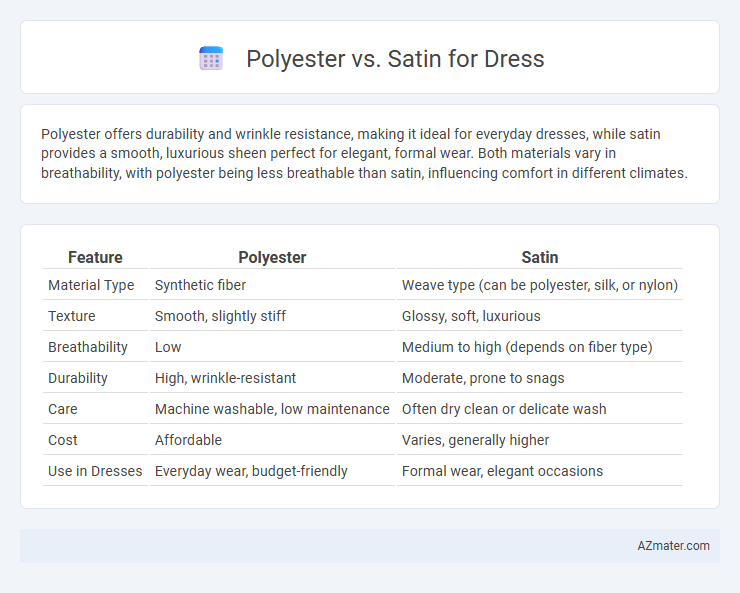Polyester offers durability and wrinkle resistance, making it ideal for everyday dresses, while satin provides a smooth, luxurious sheen perfect for elegant, formal wear. Both materials vary in breathability, with polyester being less breathable than satin, influencing comfort in different climates.
Table of Comparison
| Feature | Polyester | Satin |
|---|---|---|
| Material Type | Synthetic fiber | Weave type (can be polyester, silk, or nylon) |
| Texture | Smooth, slightly stiff | Glossy, soft, luxurious |
| Breathability | Low | Medium to high (depends on fiber type) |
| Durability | High, wrinkle-resistant | Moderate, prone to snags |
| Care | Machine washable, low maintenance | Often dry clean or delicate wash |
| Cost | Affordable | Varies, generally higher |
| Use in Dresses | Everyday wear, budget-friendly | Formal wear, elegant occasions |
Understanding Polyester and Satin: Key Differences
Polyester is a synthetic fiber known for its durability, wrinkle resistance, and affordability, commonly used in everyday dresses. Satin refers to a weaving technique that creates a smooth, glossy surface typically made from polyester, silk, or nylon, offering a luxurious and elegant appearance. Key differences lie in polyester being a fabric material and satin being a fabric finish, impacting texture, sheen, and dress suitability.
Fabric Composition: What Are Polyester and Satin Made Of?
Polyester is a synthetic fabric made from petrochemical-based polymers, primarily polyethylene terephthalate (PET), known for its durability and resistance to wrinkles and shrinking. Satin refers to a weave pattern rather than a specific material and can be made from polyester, silk, nylon, or other fibers, resulting in a smooth, glossy surface with a matte back. When choosing a dress fabric, understanding that polyester satin combines the strength of polyester fibers with the lustrous finish of satin weave helps balance affordability, sheen, and comfort.
Texture and Appearance: Gloss, Smoothness, and Drape
Polyester fabric offers a versatile texture with a smooth, often matte finish and a firm drape that holds structured styles well. Satin, typically made from silk or synthetic fibers like polyester, showcases a high-gloss, reflective surface with an ultra-smooth feel and a fluid, flowing drape that enhances elegance in formalwear. The lustrous sheen of satin contrasts sharply with the subtler shine of polyester, making satin a preferred choice for luxurious dresses emphasizing softness and shine.
Comfort and Breathability: Which Fabric Feels Better?
Polyester dresses often feel less breathable due to their synthetic fibers, trapping heat and moisture, which can reduce comfort during extended wear. Satin, primarily made from silk or polyester blends, offers a smoother texture but may vary in breathability depending on its fiber content; silk satin provides better airflow and moisture-wicking properties. For maximum comfort and breathability, satin made from natural fibers typically feels better against the skin, while polyester may be more durable but less forgiving in warm conditions.
Durability and Longevity: Polyester vs Satin Performance
Polyester offers superior durability and resistance to wear, making it highly suitable for everyday dresses that require longevity and easy maintenance. Satin, often made from silk or synthetic fibers, provides a luxurious sheen but is more prone to snagging and wear, reducing its lifespan with frequent use. Choosing polyester ensures lasting fabric strength, while satin excels in elegance but demands delicate care to maintain its appearance.
Maintenance and Care: Cleaning and Ironing Tips
Polyester dresses are low-maintenance, as they resist wrinkles and can be machine-washed on a gentle cycle, drying quickly without special care. Satin, often made from silk or synthetic fibers, requires delicate hand washing or dry cleaning to preserve its smooth texture and sheen, and ironing must be done on a low setting with a cloth barrier to prevent damage. Proper care for each fabric ensures longevity: polyester thrives with simple laundering, while satin demands cautious cleaning and careful ironing to avoid fabric distortion or shine loss.
Affordability: Cost Comparison Between Polyester and Satin
Polyester dresses generally offer greater affordability due to lower production costs and widespread availability, making them a budget-friendly option for fashion-conscious shoppers. Satin, often made from silk or higher-quality synthetic blends, tends to be more expensive because of its luxurious texture and delicate manufacturing process. Choosing polyester ensures cost-effective dressing without sacrificing style, while satin provides a premium look that comes with a higher price point.
Suitability for Different Dress Styles
Polyester offers durability and wrinkle resistance, making it ideal for structured dress styles such as A-line and sheath dresses that require shape retention. Satin, with its smooth, glossy finish and fluid drape, enhances formal and evening wear like ball gowns and slip dresses, emphasizing elegance and softness. Choosing between polyester and satin depends on the desired dress silhouette, comfort, and occasion, with polyester excelling in day-to-day wear and satin preferred for special events.
Environmental Impact and Sustainability Considerations
Polyester, a synthetic fiber derived from petroleum, has a significant environmental footprint due to its non-biodegradability and high energy consumption during production, contributing to plastic pollution and microplastic shedding. Satin, often made from silk or synthetic fibers like polyester, varies in sustainability; silk satin is biodegradable and renewable but requires resource-intensive sericulture, whereas polyester satin shares the same environmental drawbacks as regular polyester. Choosing organic or recycled polyester alternatives and supporting satin made from sustainable sources can mitigate environmental impacts in dress materials.
Choosing the Right Fabric: Polyester or Satin for Your Dress
Polyester offers durability, wrinkle resistance, and affordability, making it ideal for everyday dresses or styles requiring easy care and longevity. Satin, with its smooth, glossy surface and luxurious drape, is perfect for formal or evening dresses that emphasize elegance and a polished appearance. Choosing between polyester and satin depends on the occasion, desired texture, and maintenance preferences, ensuring your dress meets both aesthetic and functional needs.

Infographic: Polyester vs Satin for Dress
 azmater.com
azmater.com